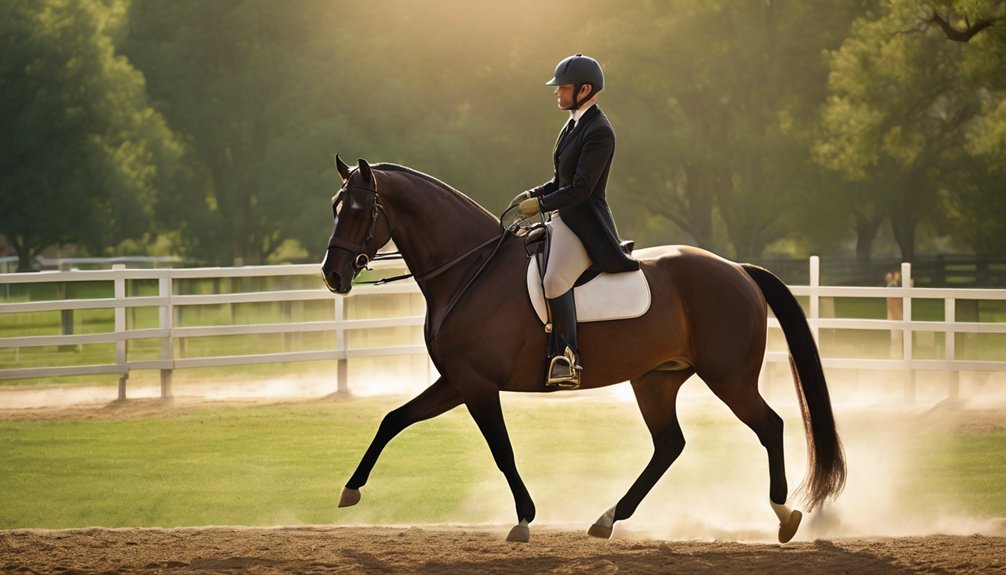
Did you know that well-conditioned eventing horses can maintain optimal performance for up to 60 minutes of intense activity? Improving your horse's stamina is crucial for achieving success in competitions, and it requires a strategic approach. You'll need to consider factors like conditioning programs, nutrition, and hydration. Understanding these elements will help you build a solid foundation for your horse's endurance. Let's explore how to create an effective plan tailored to your horse's needs.
Key Takeaways
- Conduct regular fitness assessments to establish baseline endurance levels and track progress over time.
- Implement a structured conditioning program that gradually increases workout intensity and duration to enhance cardiovascular strength.
- Incorporate interval training to alternate high-intensity bursts with recovery periods, boosting stamina effectively.
- Provide a balanced nutrition plan rich in complex carbohydrates, fats, and proteins, tailored to your horse's specific needs.
- Ensure your horse has constant access to fresh water and consider electrolyte supplements to maintain hydration during training.
Understanding Equine Endurance

When you understand equine endurance, you can better tailor your training and care routines to boost your horse's stamina effectively.
Focusing on equine physiology is essential; it helps you grasp how your horse's body utilizes energy and recovers after exertion. Conducting a stamina assessment allows you to pinpoint strengths and weaknesses in your horse's endurance capabilities. This involves observing your horse during various activities, noting heart rate recovery and breathing patterns.
By analyzing this data, you can implement targeted training strategies that enhance their performance. Additionally, consider nutrition and hydration, as proper fueling supports endurance.
Ultimately, nurturing a deep understanding of these factors fosters a stronger bond with your horse and elevates both of your experiences in eventing together.
Establishing a Conditioning Program
To effectively enhance your horse's stamina, establishing a well-structured conditioning program is essential.
Begin by conducting fitness assessments to gauge your horse's current endurance levels. This baseline will guide your training and help you set realistic goals.
Incorporate various conditioning techniques, such as steady-state work and hill training, to build cardiovascular strength and muscle endurance over time.
Gradually increase the intensity and duration of workouts to avoid injury and ensure your horse adapts to the increased demands.
Regularly reassess your horse's fitness to monitor progress and adjust the program as needed.
Incorporating Interval Training
Incorporating interval training into your horse's conditioning regimen can significantly boost stamina and performance. This method alternates periods of high interval intensity with recovery intervals, allowing your horse to build endurance effectively. Start with shorter intervals and gradually increase the duration as your horse adapts.
Here's a simple training framework:
| Interval Intensity | Duration | Recovery Intervals |
|---|---|---|
| Low | 5 min | 3 min |
| Moderate | 3 min | 2 min |
| High | 1 min | 5 min |
| Mixed | 4 min | 4 min |
Nutrition for Stamina Enhancement

Proper nutrition is vital for enhancing your horse's stamina and overall performance. To support your horse during eventing, focus on providing high-quality energy sources like complex carbohydrates, fats, and proteins. These nutrients promote endurance and recovery.
Your supplement choices can make a significant difference; consider adding electrolytes and vitamins to boost energy levels and maintain health. Omega-3 fatty acids can also enhance cardiovascular efficiency, contributing to improved stamina.
Pay attention to your horse's specific needs, as each individual might respond differently to various diets. Regularly assess your horse's body condition and energy levels to adjust their nutrition plan accordingly.
The Role of Hydration
While many horse owners focus on nutrition, hydration plays an equally crucial role in enhancing your horse's stamina. Implementing effective hydration strategies ensures your horse remains energized and ready for eventing challenges.
Start by providing fresh, clean water at all times, especially before and after workouts. Consider adding electrolyte supplements to maintain electrolyte balance, particularly during intense training or hot weather.
Monitor your horse's hydration status by checking for signs of dehydration, such as dry gums or decreased skin elasticity. Encourage drinking by offering water with added flavor or electrolytes.
By prioritizing hydration, you'll support your horse's overall performance and well-being, fostering a stronger bond through shared success in the arena.
Importance of Proper Warm-Up and Cool Down
When you prioritize a proper warm-up and cool down for your horse, you set the stage for improved stamina and performance. The warm-up benefits are crucial; it increases blood flow to the muscles, enhances flexibility, and prepares your horse mentally for the upcoming activity.
Incorporating varied exercises, such as walking, trotting, and stretching, can maximize these benefits.
After the event, don't skip the cool down techniques. Gradually reducing your horse's intensity helps prevent stiffness and aids recovery.
Walking your horse for 10-15 minutes allows their heart rate to return to normal while flushing out lactic acid.
Monitoring Your Horse's Health

Monitoring your horse's health is essential for enhancing stamina and overall performance, as even minor health issues can significantly impact their ability to train and compete effectively.
Regular health assessments are crucial; they help you track vital signs, such as heart rate and respiratory rate, which can indicate underlying problems. Pay attention to changes in appetite, energy levels, and behavior—these can signal that something's not right.
Keeping a log of your horse's health data allows you to identify trends and make informed decisions about their training regimen. Collaborate with your veterinarian to ensure your horse remains in peak condition.
Recovery Strategies for Endurance
To maximize your horse's endurance, implementing effective recovery strategies is crucial, especially after intense workouts or competitions.
Start with active recovery, which involves light exercise like walking or trotting to promote blood circulation and muscle recovery. This gentle movement helps flush out lactic acid and reduces soreness.
Incorporating massage therapy can also be beneficial; it enhances flexibility, alleviates tension, and fosters relaxation. Regular massages not only improve circulation but also create a deeper bond between you and your horse.
Monitoring your horse's response to these strategies is essential to tailor recovery practices that work best for its individual needs.
Setting Realistic Goals and Progress Tracking
How can you effectively set realistic goals for improving your horse's stamina? Start by focusing on specific, measurable outcomes. Here are three key steps to guide your goal setting and progress evaluation:
- Define Stamina Benchmarks: Identify current stamina levels and set achievable targets over time.
- Create a Training Schedule: Develop a structured program that gradually increases workload, ensuring you don't overwhelm your horse.
- Monitor Progress: Regularly assess your horse's performance through rides and workouts, adjusting goals as necessary to reflect improvements or challenges.
Frequently Asked Questions
How Do Terrain and Weather Affect My Horse's Stamina?
Terrain impacts your horse's stamina by challenging their endurance, while weather conditions can either hinder or enhance performance. Recognizing these factors helps you adjust training, ensuring your horse remains fit and ready for various environments.
Can Certain Breeds Have Naturally Better Endurance?
Just like a marathon runner's genetics can enhance performance, certain horse breeds possess endurance genetics that make them naturally suited for stamina. Understanding these breed characteristics helps you choose the right partner for long-distance challenges.
What Equipment Is Best for Endurance Training?
For endurance training, focus on saddle fit and select appropriate training gear. A well-fitted saddle ensures comfort, while quality gear enhances your horse's performance. Together, they create a supportive environment for improved stamina and success.
How Can I Tell if My Horse Is Overtrained?
To determine if your horse's overtrained, watch for fatigue signals like excessive sweating, decreased performance, or reluctance to work. Training indicators, such as a drop in heart rate recovery, can also reveal underlying fatigue.
Are There Specific Exercises to Improve My Horse's Stamina?
To improve your horse's stamina, incorporate interval training alongside long distance rides. This combination builds endurance effectively, allowing your horse to develop strength and resilience, ensuring they perform at their best during competitions and long rides.
Conclusion
Incorporating these strategies into your horse's training routine is like crafting a masterpiece—you need the right elements to create something exceptional. By focusing on conditioning, nutrition, hydration, and recovery, you're not just boosting stamina; you're building a partnership that thrives in competition. Remember, consistency is key. As you track progress and adjust your plan, your horse will not only endure the challenges of eventing but will also shine in the spotlight of success.





